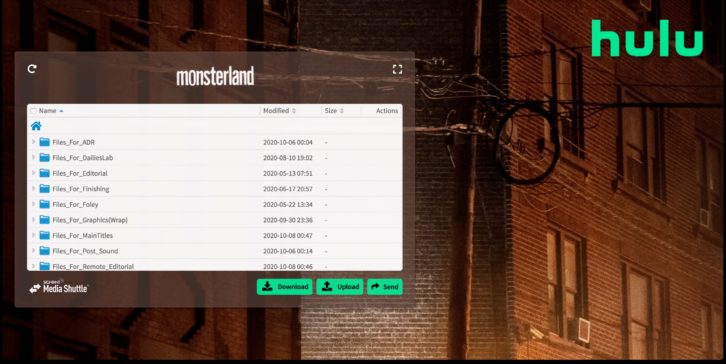“When we’re sending media to and from VFX vendors, they often use crappy FTPs, and every single vendor that’s on the job will have their own iteration of that. Trying to manage 20 or 30 different mechanisms for file IO, as opposed to a facility, on a job is a nightmare.” Jesse Korosi laughs.
Korosi is no stranger to chaotic post production workflows as director of post at Sim, a production and post production firm that supplies “niche expertise in camera, lighting, grip and power equipment rental as well as creative editorial services.” They showcase an impressive resume, which includes OJ: Made in America, HBO’s Watchmen, Deadpool 2, and Game of Thrones. With facilities and work spread across Los Angeles, Toronto, New York, Vancouver, and Atlanta, Sim is witness to an increasingly complex production supply chain with varying deadlines, production demands, larger file sizes, and an increasing amount of deliverables.
To relieve some of that complexity, Sim began using Signiant’s Media Shuttle in 2014, and more recently, adopting Signiant Jet to automate repetitive workflows. Sim’s challenges are demonstrative of the media and entertainment industry, offering a multi-layered look at how complex workflows have become and how modern tools can help solve immediate challenges and grow with as a business evolves.
Building on Signiant
In 2014, Sim relied on Aspera to move the bulk of their dailies. However, as their roster of clients, projects, and collaborators grew, they needed a simple solution to operate and adapt more easily to their evolving workflows. They turned to Media Shuttle.
Shuttle was popular with users and partners alike. Not only did the ease of use address the problems that Sim had previously, but its adaptability and customisability made collaborators feel more in control of their projects. “The dedicated portals for clients are really nice,” explains Korosi. “It just makes the client feel like it’s their own thing. It’s not a SIM thing.”
Today, Media Shuttle is a central part of Sim’s architecture. More than three hundred end-users access over 120 customised portals to share large, high-value assets from anywhere, any time. But that was just the beginning of the Sim-Signiant relationship.
While Media Shuttle offers Sim an easy, fast, and secure way for people to work with the files they need, increased production demands, remote contributors, and expanded deliverables have made workflows increasingly complicated and manually intensive.
That’s where Signiant Jet came in. Jet offers a perfect complement to Media Shuttle to automate regular transfers between locations and frees up personnel to concentrate on more high-leverage tasks.
“Our need was for a simple, fast facility-to-facility transfer mechanism between various sites. Jet targets that exact need,” Liam Ford, Sim’s senior vice president of Post Engineering, says. That simplicity proved to be a crucial motivator for Sim’s decision to select Jet.
Simplicity wins
Jet is built on the same hybrid SaaS platform as Media Shuttle, which proved to be a great benefit for Sim. Where Shuttle supports ad-hoc workflows with people involved, Jet adds automation to the mix of power and simplicity. Since it’s built on the same platform as Shuttle, Sim already had its storage endpoints connected to Signiant’s SaaS platform. That made Jet an advantageous choice when they needed to automate certain tasks.
Sim’s workflows have always necessitated several different solutions for their supply chains’ different demands because of their content’s size and diversity. While some organisations force a solution meant for one purpose to meet all needs–whether it’s suited to them or not–Signiant’s approach provides flexibility while making it all very easy to deploy and operate. As such, Sim selected Jet, in no small part because of its powerful automation and intuitive design. Sim leverages Media Shuttle and Jet together, each serving them in distinct and essential ways. The key for Sim was the flexibility to adapt while keeping things simple to operate.

“Jet fit that bill. It hit all the sweet spots of simplicity and reliability because it’s integrated into the SDCX server software that we already run for all of our Media Shuttle instances,” Ford explains. “We already have servers set up for it, so it just fit very easily into our infrastructure.”
According to Ford, Jet was one of several solutions considered, many of which sold themselves on numerous features and capabilities. But for all the bells and whistles these tools offered, they presented a challenge for both administrators and end-users, who would find themselves trying to learn a whole other platform, onboard necessary team members, and then go through the constant work of overseeing the increasingly complicated tools.
“[Ease-of-use] is a huge advantage to me because it means that I don’t have to teach people how to set up software or install the client software that connects to a non-web UI server. I don’t want to deal with any of that stuff,” says Ford. “That’s a big reason why I like Jet more than the competitors; I could use our existing constellation of Media Shuttle servers to enable Jet to work.”
Simplify the Post Production Supply Chain with Jet
“There was confusion and a lot of engineering involvement in trying to constantly re-educate people,” Ford says, reflecting on the challenges his team faced before adopting Jet. “That was a big thing that needed to be solved.”
Since deploying Jet, the software has become a significant element in Sim’s technology stack, with increasing amounts of regularly transferred content. “This has helped us make our teams more comfortable with the process and idea of sending media back and forth to other facilities for collaboration purposes,” Ford continues.
Collaboration is central to Sim’s business, and facilitating workflows involving discreet locations and teams is necessary to enable that. Moving 2K, 4K, 6K, and 8K files fast between people and facilities is what makes the work they do possible. Having the production teams feel as though they needed to find workarounds to such a critical process was frustrating.
“We are doing more because it’s easier,” Ford says. “Whereas, in the past, people might have tried to figure out a way not to collaborate because they were uncomfortable with the way that our facility-facility transfers worked before–now it’s easy.”
Now, that frustration has begun to abate, with Jet allowing Sim to swiftly move in-progress proxies, original sources, sequences, and software projects with ease. Concerns about speed and security are addressed with Signiant, even as the organisation increasingly uses larger and larger files, like 6K and 8K.
“If we have a show that we’re working on in two separate facilities, we use Jet to automate transfers back and forth, either raw media or the effect shots that get delivered to one location,” Ford explains.”Jet allows us to quickly and easily update our remote locations’ project with the most current files.”
“We’ve also used it to enhance our deliverables pipeline. For instance, if we have a show in New York, and we need LA to create the deliverables, it makes it easy to pop that material over to them.”
Jet connects global locations
Jet makes working across locations easier than ever. Because Sim’s facilities are global, teams need access to the most up-to-date version of a file so that they don’t waste time working on something that’s no longer relevant. This requires constant communication and tools that guarantee an asset is where it needs to be, when it needs to be there, and in the most up-to-date form.
Offering a simple way to automate file movement along complex global supply chains, Jet empowers Sim to improve content exchange both internally and with partners, which include some of the biggest names in M&E.
“Jet is simple and flexible yet powerful within our product suite,” said Rick Clarkson, Signiant’s chief strategy officer. “The simplicity and flexibility extend our solutions beyond a single company by making it easy to interconnect the media supply chain securely.”
Sim is just one example of a trend dominating modern M&E: the need for fast, secure content exchange within and between companies. With Signiant’s unique software-defined content exchange (SDCX) SaaS platform, media organisations, large and small, become more agile, flexible, and better able to navigate increasingly complex supply chains. Sim is a great example of when modern thinking and the right tools are put in place, the results can be monumental, and the industry as a whole finds itself in a better position to continue evolving, creating, and connecting.







